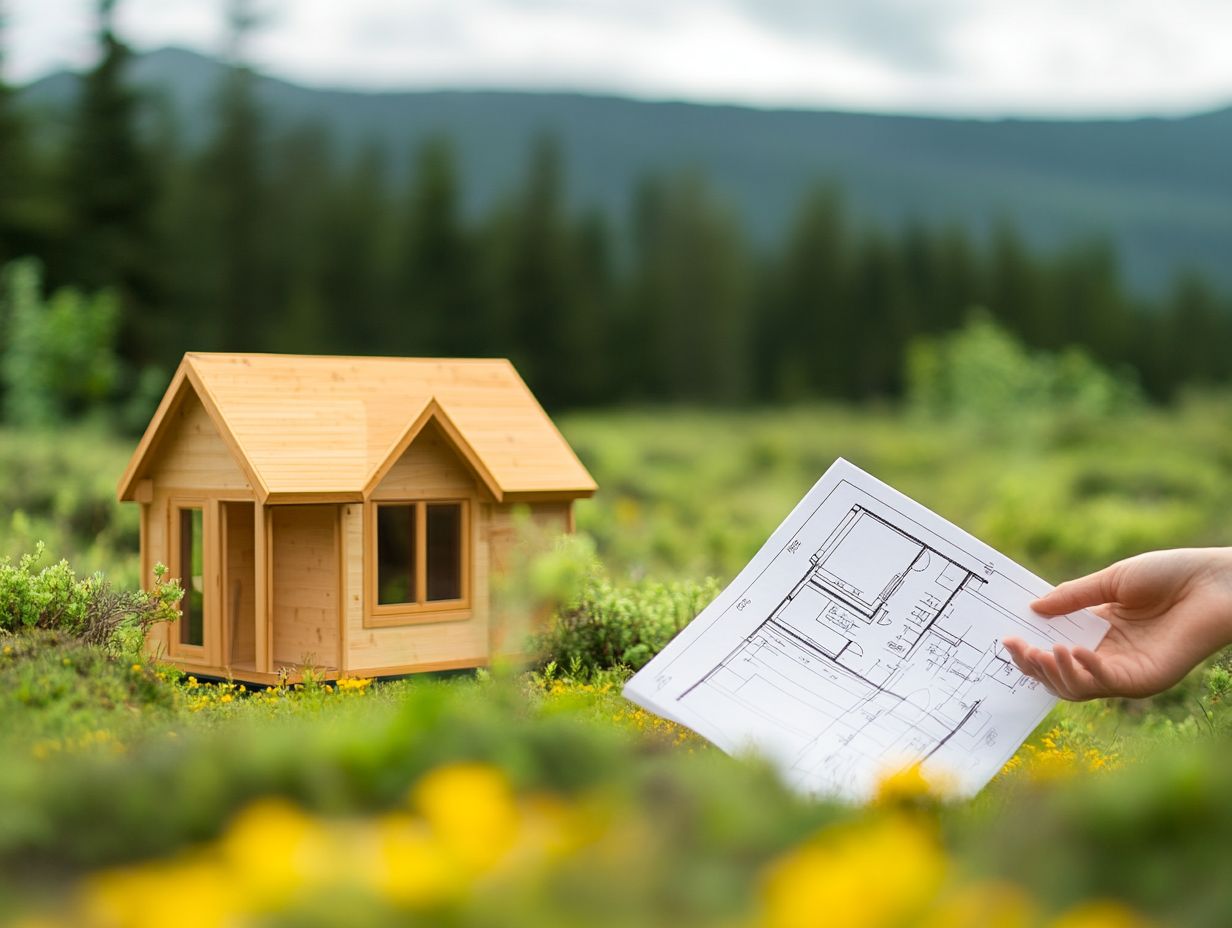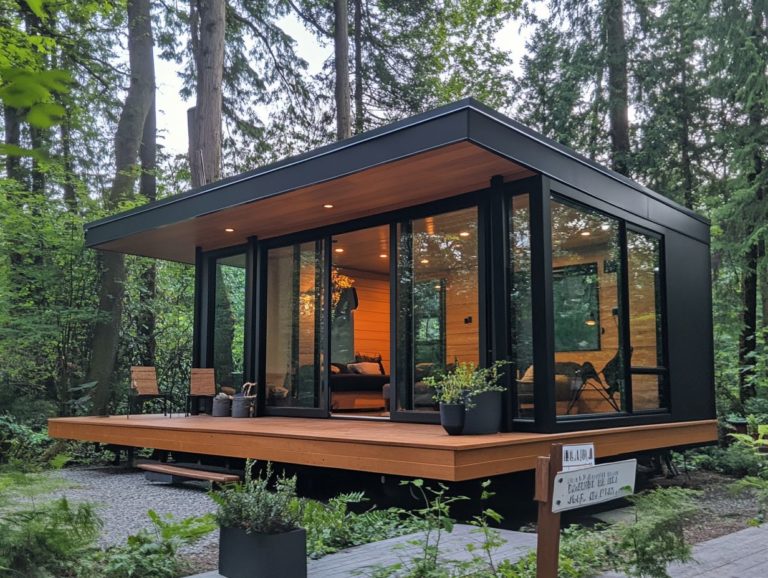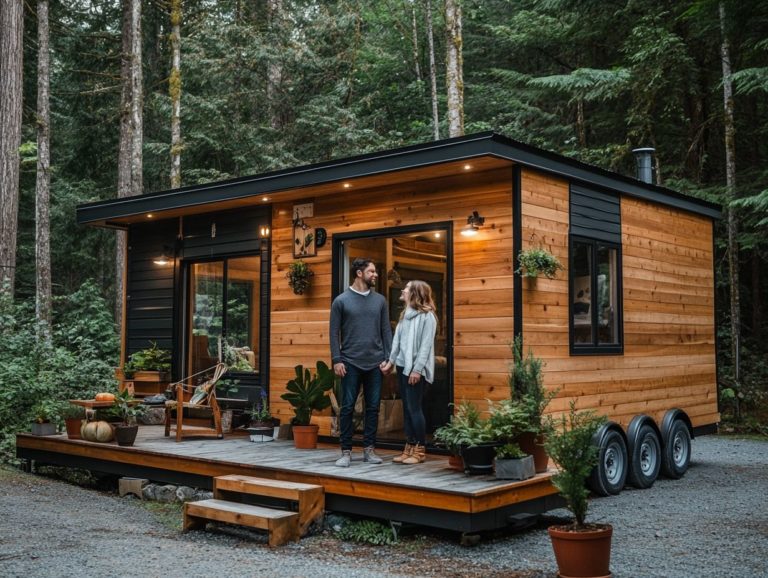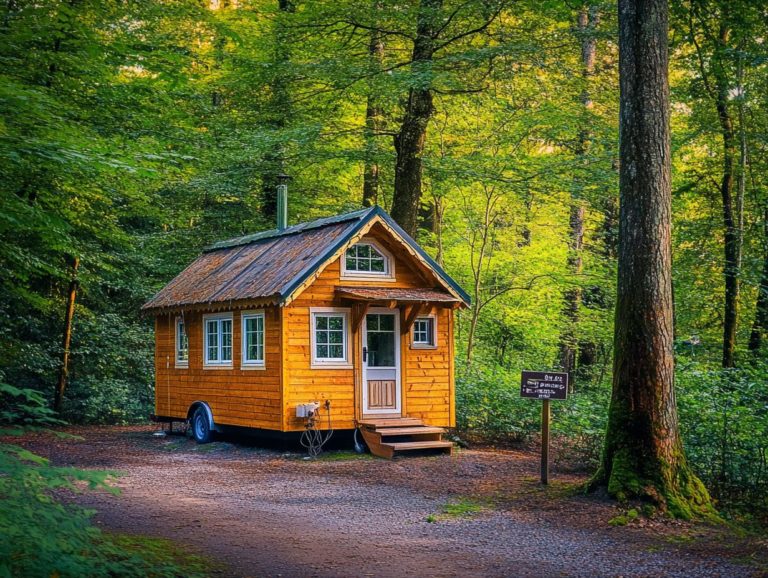Building Tiny Houses: Legal Guidelines You Need
Tiny houses are changing the way we live embrace simplicity, sustainability, and freedom.
If you’re intrigued by the concept of tiny houses and want to navigate the intricacies of building one, you’ve come to the ideal source for guidance.
This article will detail essential legal considerations, including rules about where you can place your tiny house, building codes, necessary permits, and inspections.
You’ll also explore crucial factors like location, design strategies, budgeting tips, and how to maintain a sustainable living space.
Are you ready to embark on your journey into the world of tiny homes? Let s dive in!
Contents [hide]
- Key Takeaways:
- Understanding Tiny Houses
- Legal Considerations for Building a Tiny House
- Choosing a Location for Your Tiny House
- Building and Designing Your Tiny House
- Costs and Budgeting for a Tiny House
- Maintaining and Living in a Tiny House
- Frequently Asked Questions
- What are the legal guidelines for building tiny houses?
- Do I need a building permit to build a tiny house?
- What are zoning regulations, and how do they affect tiny house construction?
- Are there size limitations for tiny houses?
- Do I need to follow building codes when building a tiny house?
- Can I live in a tiny house full-time?
Key Takeaways:

- Zoning and building codes are vital. Always research and follow local rules to avoid any hassle.
- When choosing a location for your tiny house, consider access to utilities, proximity to your daily needs, and the availability of a suitable foundation.
- Building a tiny house involves careful planning and budgeting. Factor in costs for materials, permits, and ongoing maintenance to create a realistic budget for your project.
Understanding Tiny Houses
Understanding tiny houses means appreciating their unique charm and practicality in the landscape of alternative housing options. These compact living spaces, typically under 400 square feet, promote a minimalist lifestyle.
This lifestyle increasingly attracts those seeking to downsize or achieve mortgage-free living.
In California, cities such as Fresno, Los Angeles, San Diego, and San Francisco have witnessed a surge in tiny house communities, where residents benefit from shared outdoor spaces and a strong sense of camaraderie.
Yet, the allure of tiny homes often brings its own set of challenges, particularly concerning zoning regulations and building codes that can fluctuate from one locality to another.
What are Tiny Houses?
Tiny houses are compact living spaces that typically range from 100 to 400 square feet, crafted to maximize your living area while promoting a minimalist lifestyle.
These innovative structures often boast smart layouts, featuring lofted sleeping areas, multifunctional furniture, and energy-efficient appliances.
Many tiny homes use construction materials that are eco-friendly, showcasing creative designs that resonate with your desire for sustainability.
The allure of tiny houses lies not just in their distinctive aesthetics, but also in their affordability and reduced environmental impact.
As the push for simpler living grows stronger especially among millennials and eco-conscious individuals the tiny house movement is gaining momentum. This trend is reshaping traditional notions of home ownership and inspiring a more intentional way of living.
Legal Considerations for Building a Tiny House
Navigating the legal landscape for building a tiny home can be quite intricate, especially in California, where zoning regulations and building codes differ greatly from one county or city to another.
It’s crucial for you to grasp these legal requirements if you’re contemplating the construction of a legitimate tiny home. Compliance with local planning departments is not just a detail; it can significantly impact the viability of your project.
Understanding these nuances will enable you to move forward with confidence and clarity.
Ready to build your tiny dream home? Start planning today!
Zoning and Building Codes
Zoning and building codes are very important for tiny homes. They determine where you can place them and how they must be built to meet safety standards.
In California, these rules can vary greatly from one place to another. As a prospective tiny home owner, you must navigate complex regulations from city or county governments.
Local authorities have significant control over where tiny homes can be located. They might limit tiny homes to specific areas or require them to be in designated RV parks.
The California Building Standards Commission emphasizes following construction guidelines. These regulations help ensure that tiny homes meet essential safety and health criteria.
For anyone looking to invest in or build tiny homes, knowing the importance of zoning guidelines is crucial. Compliance is about legality, but it also ensures resident safety and community harmony.
Permits and Inspections

Obtaining building permits and going through inspections are critical steps. They ensure your tiny home meets all legal requirements and safety standards.
These permits change depending on where you are. As a potential tiny home dweller, it s important to understand zoning laws, which may restrict where you can place your home.
Inspections confirm your home meets electrical, plumbing, and structural codes. This extra layer of assurance ultimately protects your well-being.
By navigating these compliance processes, you not only safeguard your investment but also contribute to a safer community.
Choosing a Location for Your Tiny House
Selecting the ideal location for your tiny house is a pivotal choice. It can greatly influence your lifestyle and living experience.
In vibrant states like California, you ll find many options, from charming tiny house communities to inviting RV parks like Park Delta Bay.
Each choice has unique benefits that shape your tiny house living experience.
Factors to Consider
When choosing a location for your tiny house, consider accessibility to essential services. Also think about the availability of outdoor space and the overall vibe of the community.
These factors significantly impact your daily life and long-term enjoyment. What community amenities matter most to you? Nearby parks, grocery stores, and recreational facilities can greatly enhance your experience.
Outdoor space is vital for relaxation and activities, especially if you love nature. Climate also plays a big role, affecting your heating, cooling, and landscaping choices.
Finding a location that effectively blends these factors will ensure a fulfilling tiny living experience that aligns with your property ownership goals.
Building and Designing Your Tiny House
When building and designing your tiny house, meticulous planning is essential. This process allows you to make the most of your space while following construction standards and reflecting your personal style.
Explore unique construction materials and innovative techniques that bring your vision to life. Exciting opportunities await!
Materials and Techniques
Choosing the right construction materials shapes your home’s look and feel while serving your functional needs and adhering to building standards.
This decision influences not just the visual appeal of your home but also its durability, energy efficiency, and sustainability. For instance, opting for reclaimed wood or advanced composite materials can significantly lower your ecological footprint while opening up unique design possibilities.
Embracing innovative building techniques like modular construction (where sections are built off-site and assembled at your location) or prefabrication can streamline the entire process, ensuring that every component meets safety regulations. By integrating these options, you can achieve a harmonious balance between modern living and compliance, creating a tiny sanctuary that is both stylish and resilient against the elements.
Space-Saving Design Tips

Incorporating space-saving design tips into your tiny house can dramatically enhance your living experience, making it both functional and comfortable within those cozy dimensions.
By thoughtfully planning your layout and selecting multifunctional furniture, you can ensure that even the smallest areas serve multiple purposes. Take, for example, a convertible sofa bed; it effortlessly transforms from a stylish living area into a restful sleeping space, ensuring that every piece plays a crucial role in your home.
Utilizing vertical storage solutions, like wall-mounted shelves and hooks, allows you to maximize your vertical space without cluttering the floor, creating an open and airy feel. Integrating outdoor spaces, such as a quaint patio or balcony, extends your living area into nature, offering a serene spot for relaxation and a charming venue for entertaining.
These strategies cultivate a harmonious balance between efficiency and style, enhancing your living in a tiny house experience.
Costs and Budgeting for a Tiny House
Budgeting for a tiny house requires a keen understanding of the various costs tied to construction, permits, and ongoing expenses. Effective financing is essential for aspiring homeowners like you, making your dream of a minimalist lifestyle a reality today!
Breaking Down Expenses
Breaking down expenses for your tiny house involves a thorough analysis of costs associated with construction materials, utilities, and potential land leasing key components to achieving that coveted mortgage-free lifestyle. In areas like California, understanding zoning regulations is crucial.
As a prospective tiny house owner, weigh factors like insurance for tiny homes, maintenance, and property taxes, all of which contribute to your overall financial landscape. By meticulously budgeting these elements, you can explore creative financing options, including personal loans. Additionally, consider looking into tiny house communities as a practical option. Think about building your home with salvaged materials or choosing sustainable energy solutions that can significantly cut down on utility bills.
Engaging in tiny house communities or community co-housing arrangements can help minimize land leasing costs, allowing you to allocate your resources to the essentials without the weight of traditional mortgages. This holistic approach not only cultivates a sense of community but also encourages an environmentally friendly lifestyle, perfectly aligning with the minimalist philosophy that tiny house enthusiasts often cherish.
Maintaining and Living in a Tiny House
Living in and maintaining a tiny house presents a distinctive blend of challenges and rewards, highlighting a sustainable lifestyle that makes the most of every inch, both indoors and outdoors, while navigating the building codes and inspection process required by local authorities.
Tips for Sustainable Living
Adopting sustainable living practices in a tiny house elevates your lifestyle while minimizing your environmental impact. This creates a seamless harmony between your indoor space and the great outdoors. Many tiny house owners in California have embraced these practices.
This balance enables you to embrace a simpler, more intentional way of living while maximizing efficiency. By choosing energy-efficient appliances and optimizing insulation, you can significantly reduce energy consumption. This results in lower utility bills and a smaller carbon footprint, all while adhering to local building standards.
Incorporating solar panels allows you to harness renewable energy, effectively transforming your tiny abode into a self-sustaining haven. Resource conservation is vital; implementing rainwater collection systems enhances water efficiency. Additionally, composting organic waste enriches the soil for outdoor gardening pursuits, improving your outdoor space.
With a touch of creativity, you can organize shared spaces and make the most of nature. Turn even the smallest yards into productive areas for growing vegetables or tranquil retreats for relaxation, perfect for enjoying the tiny house lifestyle.
Frequently Asked Questions

What are the legal guidelines for building tiny houses?
The legal guidelines for building tiny houses vary by location, including cities like Los Angeles and San Diego. Generally, you will need to obtain building permits, follow zoning regulations, and meet safety standards. Understanding these guidelines helps avoid costly mistakes.
Do I need a building permit to build a tiny house?
Yes, in most cases, you will need a building permit to build a tiny house. However, some areas may have exemptions for structures below a certain square footage, so check with your local planning department.
What are zoning regulations, and how do they affect tiny house construction?
Zoning regulations are rules that determine where buildings can be located. For tiny houses, this typically means being classified as a mobile home or RV, which may limit where you can park or build your tiny house, especially in areas like Fresno and San Francisco.
Are there size limitations for tiny houses?
Yes, there are often size limitations for tiny houses based on zoning regulations. For example, some areas may have a minimum square footage requirement for dwellings, impacting the tiny house size.
Do I need to follow building codes when building a tiny house?
Yes, following building codes when constructing a tiny house is crucial to ensure it meets safety standards. This includes regulations for plumbing, electrical work, and structural integrity, as well as the California Building Standards Code.
Can I live in a tiny house full-time?
Living in a tiny house full-time is possible, but it may not be legal in all areas, including California. Some places have restrictions on permanent dwellings classified as mobile homes or RVs. It s important to research and comply with local authorities.
Don t hesitate to connect with local experts for your tiny house journey!






